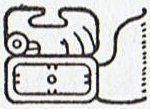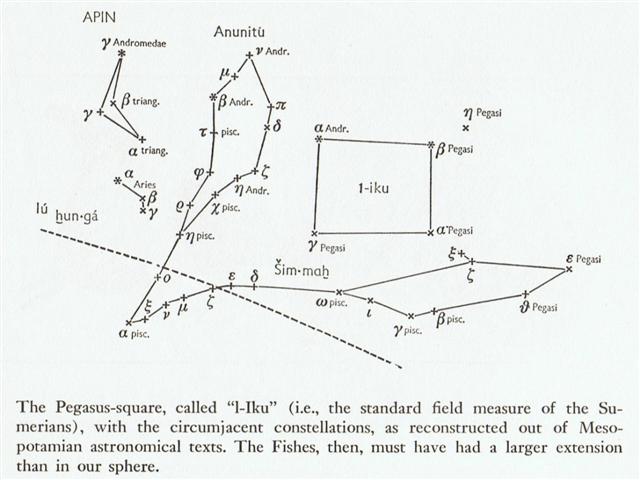461. The fundamental C text idea of
1½ (= 3 / 2) can be expressed by counting 366 * 3 /
2 = 549 (= 9 * 61 = 3 * 183):
|
393 + 349 =
742
= 1½ * 366 + 193 |
|
174 |
157 |
136 |
200 |
75 |
=
742 |
|
348 |
314 |
272 |
400 |
150 |
=
1484 |
|
522 |
471 |
408 |
600 |
225 |
=
2226 |
|
2226 = 1½ * 1484 |
 |
128 |
 |
44 |
|
Ca3-12 (63) |
Ca7-24 (192) |
|
348 / 2 =
174
= 6 * 29 |
 |
155 |
zero |
|
Ca9-9 (237) |
|
314 / 2 =
157 |
|
120 |
 |
15 |
 |
199 |
 |
11 |
zero |
62 |
|
Cb6-6 (63 + 450) |
Cb6-22 (63 + 466) |
Cb14-8 (63 + 666) |
|
272 / 2 =
136 |
400 / 2 =
200
= 336 - 136 |
150 / 2 =
75 |
Glyph 192
ought to
have represented day 193
(= 183 + 10) because
Sirrah was
at the Full
Moon at
position
zero on side
a:
 |
|
Ca7-24
(192) |
And this number
(193) should have alluded to
Castor (the Beaver, the hairy twin,
kiore hiva),
|
Kiore.
Rat.
Vanaga.
Rat,
mouse; kiore hiva,
rabbit. P Pau.,
Mgv.: kiore,
rat, mouse. Mq.:
kioē,
íoé,
id. Ta.:
iore,
id.
Churchill.
 |
together with the way
down to Hades, for Castor
(*113.4 = *41.4 + *72.0)
rose with the Sun in July 12
(193 = 183 + 10).
... That
there is a whirlpool in the
sky is well known, it is
most probably the essential
one, and it is precisely
located. It is a group of
stars so named (zalos)
at the foot of Orion, close
to Rigel (beta Orionis,
Rigel being the Arabic word
for 'foot'), the degree of
which was called 'death',
according to Hermes
Trismegistos, whereas the
Maori claim outright that
Rigel marked the way to
Hades (Castor indicating the
primordial homeland) ...

The
culmination of Castor
coincided with the Full Moon
at Terminalia:
 |
 |
 |
|
Ca12-21 |
Ca12-22 |
Ca12-23
(339) |
|
te niu ku
hakatu ua |
te
maitaki -
kupega tuku
hia mai |
mata
hakatuu |
|
Tutu.
1. Circle of
fishing nets
arranged in
the shape of
a funnels or
baskets. 2.
To light a
fire;
he-tutu i te
ahi: to
burn
something.
3. To hit,
to strike,
to beat.
Tûtú, to
shake
(something)
clean of
dust or
dirt;
he-tûtú te
oone o te
nua, to
shake the
dirt off a
nua
cape.
Tutuhi,
to reject
the
responsibility
for a
mistake onto
one another,
to blame one
another for
a mistake
(see tuhi).
Tutuki,
to stumble,
to trip.
O tutuki te
va'e, in
order not to
trip.
Tutuma,
firebrand,
partly burnt
stick.
Tuturi,
to kneel.
Vanaga. 1.
To beat bark
for cloth.
PS Pau.,
Mgv., Mq.,
Ta.: tutu,
id. Sa.,
To., Fu.:
tutu,
id. 2. A
broom, to
sweep, to
clean. Mq.:
tutu,
to beat out
the dust. 3.
To shake, to
winnow.
Mgv.:
tutu, to
tremble, to
leap. Mq.:
tutu,
to shake. 4.
To kindle,
to light, to
ignite, to
set fire, to
burn. Mq.:
tutu,
to burn, to
set fire. 5.
To stand;
hakatutu,
to set
joists. P
Mgv., Mq.:
tutu,
to stand
upright.
Ta.: tu,
id. Tutua
(tutu
1): board on
which bark
is beaten
into cloth.
PS Mgv.:
tutua, a
cloth
beater. Mq.,
Ta.:
tutua,
wood on
which cloth
is beaten.
Sa., Fu.:
tutua,
id. Tutui:
tutui
ohio,
chain,
tutui kura,
shawl. Mq.:
tuitui
kioé,
chain.
Tutuki:
shock,
contusion,
to run
against, to
collide;
tukukia,
to run foul
of. P Pau.:
tukituki,
to strike,
to pound, to
grind. Mgv.:
tukia,
to strike
against,
shock,
concussion.
Mq.:
tutuki,
id. Ta.:
tui, id.
Tutuma:
1. (tutu
- ma)
a live coal.
2. Tree
trunk T (?
tumu).
Tutumata,
ligament of
the eye,
orbit,
eyelid. T (tutumate,
eyelid G).
Tutuu,
bristling.
Churchill.
Tuu.
1. To stand
erect. 2.
Mast,
pillar,
post. Van
Tilburg. 1.
To stand
erect, mast,
pillar,
post; tuu
noa,
perpendicular;
tanu ki
te tuu,
to set a
post;
hakatu tuu,
to step a
mast; tuu
hakamate
tagata,
gallows;
hakatuu,
to erect, to
establish,
to
inactivate,
to form,
immobile, to
set up, to
raise. P
Mgv., Mq.,
Ta.: tu,
to stand up.
2. To exist,
to be. Mgv.:
tu,
life, being,
existence.
3. To
accost, to
hail; tuu
mai te vaka,
to hail the
canoe. Mgv.:
tu, a
cry, a
shout. 4. To
rejoin;
tuua to
be reunited.
5.
Hakatuu,
example,
mode,
fashion,
model,
method,
measure, to
number. PS
Sa.: tu,
custom,
habit. Fu.:
tuu,
to follow
the example
of. 6.
Hakatuu,
to
disapprove;
hakatuu
riri, to
conciliate,
to appease
wrath. 7.
Hakatuu,
to presage,
prognostic,
test. 8.
Hakatuu,
to taste. 9.
Hakatuu,
to mark,
index,
emblem,
seal, sign,
symbol,
trace,
vestige,
aim;
hakatuu ta,
signature;
akatuu,
symptom;
hakatuua,
spot, mark;
hakatuhaga,
mark;
hakatuutuu,
demarcation.
Churchill.
1. To
arrive:
tu'u-mai.
2. Upright
pole; to
stand
upright
(also:
tutu'u).
3. To guess
correctly,
to work out
(the meaning
of a word)
correctly:
ku-tu'u-á
koe ki te
vânaga,
you have
guessed
correctly
[the meaning
of] the
word. 4. To
hit the
mark, to
connect (a
blow). 5.
Ku-tu'u
pehé, is
considered
as... ;
te poki to'o
i te me'e
hakarere i
roto i te
hare,
ku-tu'u-á
pehé poki
ra'ura'u,
a child
who takes
things that
have been
left in the
house is
considered
as a petty
thief.
Tu'u aro,
northwest
and west
side of the
island.
Tu'u
haígoígo,
back tattoo.
Tu'u
haviki,
easily
angered
person.Tu'u-toga,
eel-fishing
using a line
weighted
with stones
and a hook
with bait,
so that the
line reaches
vertically
straight to
the bottom
of the sea.
Tu'utu'u,
to hit the
mark time
and again.
Tu'utu'u
îka,
fish fin
(except the
tail fin,
called
hiku).
Vanaga. ...
To the
Polynesian
and to the
Melanesian
has come no
concept of
bare
existence;
he sees no
need to say
of himself
'I am',
always 'I am
doing', 'I
am
suffering'.
It is hard
for the
stranger of
alien
culture to
relinquish
his nude
idea of
existence
and to adopt
the island
idea; it is
far more
difficult to
acquire the
feeling of
the language
and to
accomplish
elegance in
the diction
under these
unfamiliar
conditions.
Take for an
illustrative
example
these two
sentences
from the
Viti: Sa
tiko na
tamata e
kila:
there are
(sit) men
who know.
Sa tu mai
vale na yau:
the goods
are (stand)
in the
house. The
use of tu
for tiko
and of
tiko for
tu
would not
produce
incomprehensibility,
but it would
entail a
loss of
finish in
diction, it
would stamp
the speaker
as vulgar,
as a white
man ...
Savage life
is far too
complex; it
is only in
rich
civilization
that we can
rise to the
simplicity
of elemental
concepts ...
Churchill 2. |
|
CLOSE TO THE
FULL MOON: |
|
12
Dec
(337 + 10) |
13 (348) |
14 |
 |
|
DEC 19 (*273
= *337 -
*64) |
20 (354) |
SOLSTICE |
|
February 21
μ
Gruis
(337.0),
ε
Cephei
(337.2),
1/325 Lac.
(337.3),
ANCHA (Hip)
=
θ
Aquarii
(337.4),
ψ
Oct.
(337.5), α
Tucanae
(337.9)
*296 =
*337.4 -
*41.4 |
22
Al Sa'ad al
Ahbiyah-23
(Lucky Star
of Hidden
Things) /
Shatabisha-25
(Comprising
a Hundred
Physicians)
ε
Oct.
(338.1),
ρ
Aquarii
(338.2),
2/365 Lac.
(338.5),
SADACHBIA =
γ
Aquarii
(338.6),
π
Gruis
(338.9) |
23 (Terminalia)
β/172 Lac.
(339.2),
4/1100 Lac.
(339.4), π
Aquarii
(339.5)
*298 =
*339.4 -
*41.4
CASTOR (α
Gemini)
|
|
... Al Sa'd
al Ahbiyah
... has been
interpreted
the Lucky
Star of
Hidden
Things or
Hiding-places,
because when
it emerged
from the
sun's rays
all hidden
worms and
reptiles,
buried
during the
preceding
cold, creep
out of their
holes!
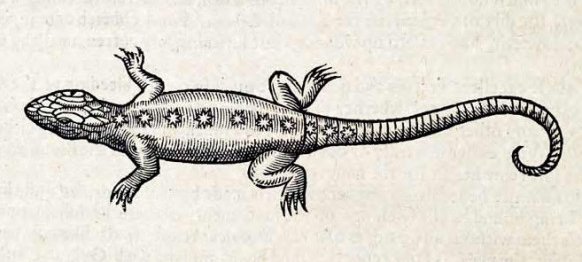 |
The
distance from Castor
rising together with the Sun
in July 12 to its culmination date
February 23 appears
to have been *298 -
*72 = *226 days. However,
the right ascension
cycle was not 365
but 366 days, which
means the distance
should be counted as
*299 - *72 = *227, a
much better number
for 22 / 7
surely referred to 314 (π).
|
Egyptian
sebchet |
 |
Phoenician
pe |
 |
Greek
pi |
Π
(π) |
|
Wikipedia:
'...
according
to a
theory
by
Theodor
Nöldeke
from
1904,
some
of
the
letter
names
were
changed
in
Phoenician
from
the
Proto-Canaanite
script
...
pit
'corner'
to
pe
'mouth'
...'
However, I think the Egyptian source hieroglyph could have been Gardiner's O14 (sebchet), a sign which illustrates a corner with feather-like ornaments upon the walls. The meaning was 'portal' according to Wilkinson. Or why not an Archway for exit, the Mayas had a 'grasping hand' (Chikin) in the west:
To be in a corner means there is no way forward.
|
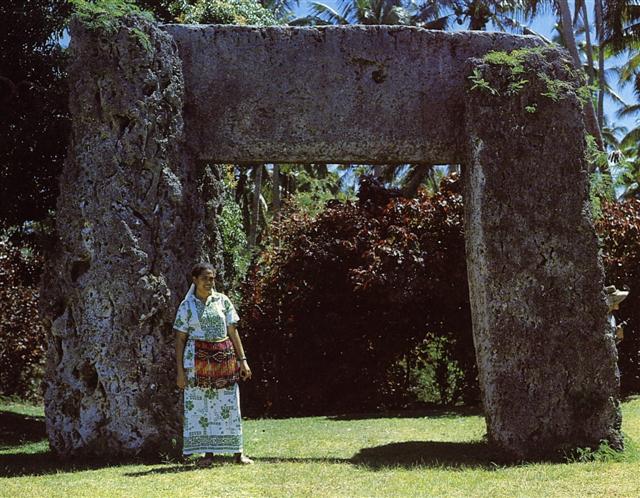
Time went
from
heliacal
day to
culmination
night,
not in the
shorter opposite
direction,
because in
the early
mornings the
Sun would
hide the
heliacal
star for at
least 16
days before
it would
become
visible
again - late
at night.
I.e., in his
year the
Sun moved
ahead among
the stars
and as a
consequence
the stars
appeared to
drift in the
other
direction,
towards the
Sun. This
apparent
movement of
the stars in
the year was
opposite to
that caused
by the
precession.

| CASTOR |
| July 12 (193) |
226 |
Febr 23 (54, Terminalia) |
| right ascension position |
culmination |
Perhaps it
was the time
of midnight
(when the
culminating
star was
straight
above the
observer) which once
upon a time
had ended
the period
counted from
sunrise.
|
... Saturn (= Chronos, Time) is effectively telling the time by cutting it to pieces with his scythe, and the Babylonian spring sun god Marduk divided the night Tiamat (the ocean god in form of a great water monster) in half by a slash:
|
"... Marduk, die Frühsonne des Tages und des Jahres, wurde eben wegen dieses seines Charakters der Lichtbringer am Weltmorgen. Marduk, der die leblose, chaotische Nacht, die keine Gestaltungen erkennen lässt, besiegt, der den Winter mit seinem Wasserfluten, den Feind des Naturlebens, überwindet, wurde der Schöpfer des Lebens und der Bewegung, der Ordner des Regellosen, der Gestalter des Unförmlichen am Weltmorgen ...
Die Sonne, die des Morgens das Weltmeer durchschreitet und besiegt und das Licht bringt, lässt aus dem Chaos der Nacht zuerst den Himmel, dann erst die Erde hervortreten, spaltet das gestaltlose Reich der Nacht in die zwei Hälften, den Himmel und die Erde ..." (Jensen) |
The Apophis snake is similarly ‘finished’ by ‘knives’:

Wilkinson comments that magic knives were involved in destroying the enemies of the sun at each dawn and the two sycomore trees between which the sun rises each morning were called the 'two knives' ... |
But Allen
has
documented
all his
star culminations
at 21h,
which should
be due to an
effort of
keeping the
culminations
at their
proper
places
according to
the
ancients,
24h (spring
equinox) - 21h =
3h = 24h /
8 = 45º.
3h
corresponds
to 366 / 8 =
45.75 of my
right
ascension
days and
*366 - *46
= *320
(Dramasa):
| no glyph |
koia |
ki te hoea |
ki te henua |
te rima te hau tea |
haga i te mea ke |
ki te henua - tagata honui |
 |
 |
 |
 |
 |
 |
| Ca1-1 |
Ca1-2 |
Ca1-3 (121 - 118) |
Ca1-4 |
Ca1-5 |
Ca1-6 |
| CLOSE TO THE FULL MOON: |
| 10 Jan (80 - 70) |
11 |
12 |
13 |
14 |
15 |
16 |
| JAN 16 (80 - 64) |
17 |
18 |
19 |
20 |
21 |
22 |
| March 21 (80)
Al Fargh al Thāni-25 (Rear Spout)
0h (365.25)
CAPH (Hand) = β Cassiopeiae, SIRRAH (Navel of the Horse) = α Andromedae (0.5), ε Phoenicis, γ³ Oct. (0.8) |
22
Uttara Bhādrapadā-27 (2nd of the Blessed Feet) / Wall-14 (Porcupine)
ο Oct. (1.3), ALGENIB PEGASI = γ Pegasi (1.8) |
23
χ Pegasi (2.1), θ Andromedae (2.7) |
24
σ Andromedae (3.0), ι Ceti (3.3), ζ Tucanae (3.5), ρ Andromedae, π Tucanae (3.7) |
25 (84)
no star listed (4) |
26
ANKAA = α Phoenicis, κ Phoenicis (5.0)
ALPHARD (α Hydrae)
|
27
λ Phoenicis (6.3), β Tucanae (6.4) |
| CLOSE TO THE SUN: |
| 12 July |
13 (264 - 70) |
14 |
15 (196) |
16 (14 + 183) |
17 |
18 |
| JULY 18 |
19 (264 - 64) |
20 |
21 |
22 (20 + 183) |
23 |
24 |
| Sept 20 (263) |
21 |
Equinox |
23 |
24 (☼183) |
25 (*5 + *183) |
26 (☼185) |
| 24 (236 = 8 * 29½) |
'Aug 25 |
26 (265 - 27) |
27 |
28 (*160) |
(☼157 = 314 / 2) |
30 |
| "Aug 10 (222) |
11 |
12 (265 - 41) |
13 (15 * 15) |
14 |
(227 = 268 - 41) |
16 (*148) |
| ALCHITA = α Corvi, MA WEI (Tail of the Horse) = δ Centauri (183.1), MINKAR = ε Corvi (183.7), ρ Centauri (183.9) |
PÁLIDA (Pale) = δ Crucis (184.6), MEGREZ (Root of the Tail) = δ Ursae Majoris (184.9) |
Hasta-13 (Hand) / Chariot-28 (Worm)
GIENAH (Wing) = γ Corvi (185.1), ε Muscae (185.2), ζ Crucis (185.4), ZANIAH (Corner) = η Virginis (185.9)
*144.0 = *185.4 - *41.4 (= 12 * 12) |
CHANG SHA (Long Sand-bank) = ζ Corvi (186.3) |
INTROMETIDA (Inserted) = ε Crucis (187.4), ACRUX = α Crucis (187.5) *146.0 = *187.4 - *41.4 |
γ Com. Berenicis (188.0), σ Centauri (188.1), ALGORAB = δ Corvi (188.5), GACRUX = γ Crucis (188.7) |
γ Muscae (189.0), AVIS SATYRA (Bird of the Satyrs) = η Corvi (189.3), ASTERION (Starry) = β Canum Ven. (189.5), KRAZ = β Corvi, κ Draconis (189.7) |

... Raven gazed up and down the beach. It was pretty, but lifeless. There was no one about to upset, or play tricks upon. Raven sighed. He crossed his wings behind him and strutted up and down the sand, his shiny head cocked, his sharp eyes and ears alert for any unusual sight or sound. The mountains and the sea, the sky now ablaze with the sun by day and the moon and stars he had placed there, it was all pretty, but lifeless. Finally Raven cried out to the empty sky with a loud exasperated cry. And before the echoes of his cry faded from the shore, he heard a muffled squeak. He looked up and down the beach for its source and saw nothing. He strutted back and and forth, once, twice, three times and still saw nothing. Then he spied a flash of white in the sand. There, half buried in the sand was a giant clamshell. As his shadow fell upon it, he heard another muffled squeak. Peering down into the opening between the halves of the shell, he saw it was full of tiny creatures, cowering in fear at his shadow ... |
| 61 |
JAN 27 |
28 |
29 |
30 |
| MARCH 25 (84 = 27 + 57) |
26 |
27 |
28 |
 |
 |
 |
 |
| Ca3-17 (84 - 16 = 68) |
Ca3-18 (69) |
Ca3-19 |
Ca3-20 → Dramasa |
| tapamea - tagata rima iri |
te henua te hokohuki |
te kava |
te kiore i te henua |
| CLOSE TO THE FULL MOON: |
|
Itzam-Yeh (7-Macaw, Ursa Major) defeated |
20 March (79) |
21 |
22 |
|
May 28 (148)
Rohini-4 (The Red One) / Pidnu-sha-Shame-4 (Furrow of Heaven) / ANA-MURI-2 (Rear pillar - at the foot of which was the place for tattooing)
ALDEBARAN = α Tauri (68.2), THEEMIN = υ² Eridani (68.5) |
29
no star listed (69) |
30 (→ 5 * 30 = 150)
no star listed (70) |
31
TABIT = π³ Orionis (71.7), π² Orionis (71.9)
320 (South Pole star, Dramasa) - 71 (Tabit) = 249 (Antares) |
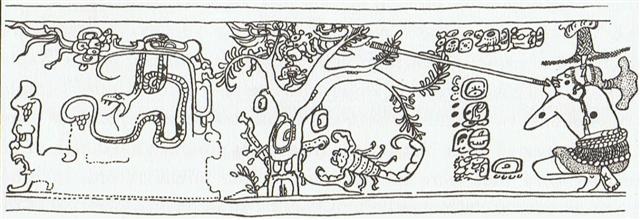
... This pot depicts one of the Hero Twins (One-Ahaw in the Classic texts and One-Hunaphu in the K'iche' Popol Vuh) and a great bird who is trying to land in a huge ceiba tree heavy with fruit. This mythical bird is Itzam-Yeh, Classic prototype of Wuqub-Kaqix, 'Seven-Macaw', of Popol Vuh fame. In that story, in the time before the sky was lifted up to make room for the light, the vainglorious Seven-Macaw imagined himself to be the sun. Offended by his pride, the Hero Twins humbled him by breaking his beautiful shining tooth with a pellet from their blowgun. This pot shows One-Ahaw aiming at the bird as he swoops down to land in his tree. As Itzam-Yeh lands on his perch, the text tells us he is 'entering or becoming the sky'. This particular 'sky-entering' is not the one mentioned in the Palenque text. It is the final event that occurred in the previous creation before the universe was remade. Before the sky could be raised and the real sun revealed in all its splendor, the Hero Twins had to put the false sun, Itzam-Yeh, in his place. If the date on this pot corresponds to that pre-Creation event, as we believe it does, then Itzam-Yeh was defeated in 12.18.4.5.0 1 Ahaw 3 K'ank'in (May 28, 3149 B.C.) ... |
| CLOSE TO THE SUN: |
| Nov 27 (148 + 183)
HAN = ζ Ophiuchi (251.0) |
28 (332 = 149 + 183)
ζ Herculis, η Tr. Austr. (252.1), η Herculis, β Apodis (252.5) |
29 (300 + 33)
ATRIA = α Tr. Austr. (253.9) |
30 (*254 = *71 + *183)
Tail-6 (Tiger)
WEI (Tail) = ε Scorpii, η Arae (254.3), DENEBAKRAB = μ Scorpii (254.7) |
Tabit (one
of 6 stars
marked π in
Orion) was at
the 'hairy fleece'
(a word
related to
the warming feather
plumes of
birds) of
the Lion and
we can guees
this
position
referred to
the 5 days
after the
northern
autumn
equinox at
the time of
the Bull, 87
(MARCH 28) + 183 = 270
(SEPTEMBER
27).

... Mad
Dog
(Lupus) The
Mad Dog is
probably a
relic of an
ancient star
configuration
which
included the
now derelict
Bison-man.
Together
they
constituted
a version of
the
'Lion-bull'
conflict,
which is
widely
thought to
symbolise
the seasonal
conflict
between
summer and
autumn. Here
the bull,
who
represents
the autumn
rains slays
the lion of
summer
...
The Tail of
the Scorpion
(Deneb
Akrab) was
at November 30
(334) - 64
days =
270
(SEPTEMBER
27) = 265
(Antares) +
5 days at
the time
when the
Full Moon
had been at
the Tail of
the Fleece
of the Old
Lion.
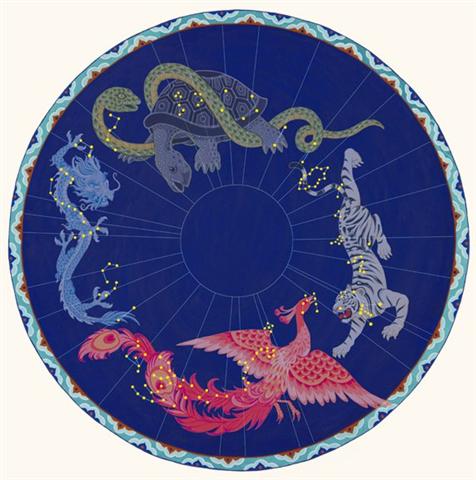
Spica at the
Tail of the
Blue Dragon
(together
with the
Tail of the
Red Bird)
had been in
day 282
(October 9)
- 64 = 218
(AUGUST 6),
which was
270 - 218 =
52 days
earlier in
the year
than the
Tail of the
Scorpion.
Similarly,
from the
Tail of the
White Tiger
(presumably
alluded to
in the
Chinese
station for
Deneb Akrab)
- together
with the
Tail of the
Green
Serpent - to
Tabit at the
Tail of the
Lion Fleece
there should
also be 52
days. Tabit
(151, May
31) - 52 =
99 = 384 -
365 = 80 +
19:
There
were
10
right
ascension
days
from
Ca3-12
at
Hyadum
I
(*63.4)
to
te
maitaki
(good)
at
Hassaleh
(together
with
the
last
of
the
6 π
Orionis
stars),

which
could
correspond
to
the
Hawaiian
perspective
of
10
days
from
the
return
of
the
Pleiades
in
the
night
sky to
the
beginning
of
the
cycle
of
Rogo:
| JAN 31 (88 - 57) |
FEBR 1 (32 = 73 - 41) |
2 |
3 |
4 (115 - 80) |
| MARCH 29 (152 - 64 = 88) |
30 |
31 |
APRIL 1 (364 / 4) |
2 |
 |
 |
 |
 |
 |
| Ca3-21 (→ March 21 → Gregorian equinox) |
Ca3-22 (73) |
Ca3-23 |
Ca3-24 |
Ca3-25 (→ March 25→ Julian equinox) |
| tagata tuu rima ki ruga |
te maitaki |
te henua |
Rei hata ia |
tagata rogo |
|
Hata. 1. Table, bureau. P Pau.: afata, a chest, box. Mgv.: avata, a box, case, trunk, coffin. Mq.: fata, hata, a piece of wood with several branches serving as a rack, space, to ramify, to branch; fataá, hataá, stage, step, shelf. Ta.: fata, scaffold, altar. 2. Hakahata, to disjoint; hakahatahata, to loosen, to stretch. P Pau.: vata, an interval, interstice. Mgv.: kohata, the space between two boards, to be badly joined; akakohata, to leave a space between two bodies badly joined; hakahata, to be large, broad, wide, spacious, far off. Mq.: hatahata, fatafata, having chinks, not tightly closed, disjointed. Ta.: fatafata, open. 3. Hatahata, calm, loose, prolix, vast. Mgv.: hatahara, broad, wide, spacious, at one's ease. Ta.: fatafata, free from care. Mq.: hatahata, empty, open. 4. Hatahata, tube, pipe, funnel. Churchill. Sa.: fata, a raised house in which to store yams, a shelf, a handbarrow, a bier, a litter, an altar, to carry on a litter; fatāmanu, a scaffold. To.: fata, a loft, a bier, a handbarrow, to carry on a bier; fataki, a platform. Fu.: fata, a barrow, a loft; fatataki, two sticks or canes attached to each other at each side of a house post to serve as a shelf. Niuē: fata, a cage, a handbarrow, a shelf, a stage, (sometimes) the upper story of a house. Uvea: fata, a barrow, a bier. Fotuna: fata, a stage. Ta.: fata, an altar, a scaffold, a piece of wood put up to hang baskets of food on; afata, a chest, a box, a coop, a raft, a scaffold. Pau.: fata, a heap; afata, a box, a chest. Ma.: whata, a platform or raised storehouse for food, an altar, to elevate, to support. Moriori: whata, a raft. Mq.: fata, hata, hataá, shelves. Rapanui: hata, a table. Ha.: haka, a ladder, an artificial henroost; alahaka, a ladder. Mg.: ata, a shelf; atamoa, a ladder; atarau, an altar. Mgv.: avata, a coffer, a box. Vi.: vata, a loft, a shelf; tāvata, a bier. The Samoan fata is a pair of light timbers pointed at the ends and tied across the center posts of the house, one in front, the other behind the line of posts; rolls of mats and bales of sennit may be laid across these timbers; baskets or reserved victuals may be hung on the ends. The litter and the barrow are two light poles with small slats lashed across at intervals. The Marquesan fata is a stout stem of a sapling with the stumps of several branches, a hat tree in shape, though found among a barehead folk. These illustrations are sufficient to show what is the common element in all these fata identifications, light cross-pieces spaced at intervals. With this for a primal signifaction it is easy to see how a ladder, a raft, a henroost, an altar come under the same stem for designation. Perhaps Samoan fatafata the breast obtains the name by reason of the ribs; it would be convincing were it not that the plumpness of most Samoans leaves the ribs a matter of anatomical inference. Churchill 2. ... Teke said to Oti, 'Go and take the hauhau tree, the paper mulberry tree, rushes, tavari plants, uku koko grass, riku ferns, ngaoho plants, the toromiro tree, hiki kioe plants (Cyperus vegetus), the sandalwood tree, harahara plants, pua nakonako plants, nehenehe ferns, hua taru grass, poporo plants, bottle gourds (ipu ngutu), kohe plants, kavakava atua ferns, fragrant tuere heu grass, tureme grass (Diochelachne sciurea), matie grass, and the two kinds of cockroaches makere and hata.' ... The division into quarters of a 28-series can be applied to the main phases of the moon during the visible period as was as to a (reflex of the old world?) sidereal month. The separate subgroup (29 makere - 30 hata) consists of the names of two types of cockroaches, but in related eastern Polynesian languages these names can also be explained on a different level. MAO. makere, among others, 'to die', and whata, among others, 'to be laid to rest on a platform', deserve special attention. The theme hinted at is one of death and burial. In our scheme they occur at just that time when the moon 'has died'! This lends further support to the lunar thesis. Barthel 2.

|
| CLOSE TO THE FULL MOON: |
| June 1
π4 Orionis (72.1), ο¹ Orionis (72.4), π5 Orionis (72.8)
*31.0 = *72.4 - *41.4 |
2 (336 - 183 = 153)
π¹ Orionis (73.0), ο² Orionis (73.4), HASSALEH = ι Aurigae (73.6), π6 Orionis (73.9) |
3
ALMAAZ (The Male Goat) = ε Aurigae (74.7), HAEDUS I = ζ Aurigae (74.8) |
4
HAEDUS II = η Aurigae (75.9) |
5
5h (76.1)
ε Leporis (76.0), CURSA = β Eridani (76.4), λ Eridani (76.7) |
| "April 21 |
22 (153 - 41 = 112) |
23 |
24 |
25 |


|
| CLOSE TO THE SUN: |
| 22 Sept (Equinox) |
23 (266 = 272 - 6) |
24 |
25 |
26 |
| SEPT 28 |
29 (2 * 136 = 336 - 64) |
30 (273) |
OCT 1 |
2 |
| Dec 1
Ophiuchi (255.3), GRAFIAS (Claws) = ζ Scorpii (255.4)
*214.0 = *255.4 - *41.4 |
2 (336 = 4 * 84)
κ Ophiuchi (256.2), ζ Arae (256.5), ε Arae (256.8), CUJAM (Club) = ε Herculi (256.9) |
3
no star listed (257) |
4
17h (258.7)
ARRAKIS = μ Draconis (258.7) |
5
Mula-19 (The Root)
SABIK (The Preceding One) = η Ophiuchi (259.7), η Scorpii (259.9) |
| "Oct 21 |
22 (336 - 41 = 295) |
23 |
24 |
25 |
| FEBR 5 (36) |
6 (37 = 78 - 41) |
7 (118 - 80) |
| APRIL 3 (*13 = *77 - *64) |
4 |
5 (95 = 118 - 23) |
|
... the Palenque scribes repeated Creation again and described it as 'it was made visible, the image at Lying-down-Sky, the First-Three-Stone-Place'. Then we learned that five hundred and forty-two days later (1.9.2 in the Maya system), Hun-Nal-Ye 'entered or became the sky' (och ta chan). This 'entering' event occurred on February 5, 3112 BC ... |
 |
 |
 |
| Ca4-1 (77) |
Ca4-2 |
Ca4-3 |
| kua tupu te rakau |
kua tupu - te kihikihi |
te hau tea |
|
Tupu. 1. Shoot, sprout, bud; to sprout, to bud. 2. Pregnant: vî'e tupu (o te poki); to be conceived (of fetus in its mother's womb): he-tupu te poki i roto i te kopú o toona matu'a. Vanaga. To grow, to sprout, to germinate, to come forth, to conceive, pregnant, germ; mea tupu, plant; tupu ke avai, of rapid growth; tupu horahorau, precocious; hakatupu, to produce, to stimulate growth, to excite. P Pau.: fakatupu, to raise up, to create. Mgv.: tupu, to grow, to conceive, to be pregnant. Mq.: tupu, to grow, to sprout, to conceive. Ta.: tupu, to grow, to sprout. Churchill. Mgv.: Tupu, the best or worst, used of men or of bad qualities. Sa.: tupu, king. Ma.: tupu, social position, dignity. Churchill. |
| CLOSE TO THE FULL MOON: |
| μ Aurigae, μ Leporis (77.6) |
ĸ Leporis (78.0), RIGEL (Foot) = β Orionis (78.1), Flaming Star = IC405 (78.2), CAPELLA = α Aurigae (78.4), ο Columbae, τ Orionis (78.8) *37.0 = *78.4 - *41.4
THUBAN (α Draconis)
|
λ Aurigae (79.0), λ Leporis (79.6), ρ Aurigae (79.7) ARCTURUS (α Bootis)
|
|
... In view of the almost universal prevalence of the Pleiades year throughout the Polynesian area it is surprising to find that in the South Island and certain parts of the North Island of New Zealand and in the neighboring Chatham Islands, the year began with the new Moon after the yearly morning rising, not of the Pleiades, but of the star Rigel in Orion ...
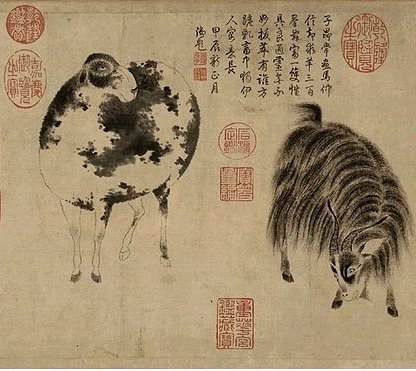
|
| June 6 (157 = 314 / 2) |
7 (*78) |
8 |
| 'May 10 (*50 = *77 - * 27) |
11 |
12 (132 = 118 + 14) |
| "April 26 (*36 = *77 - *41) |
27 |
28 (118) |
| CLOSE TO THE SUN: |
| Dec 6 (340 = 157 + 183) |
7 (*261 = *78 + *183) |
8 |
| NODUS I = ζ Draconis (260.0), π Herculis (260.7), RAS ALGETHI = α Herculis (260.8) |
SARIN = δ Herculis (261.0), ο Ophiuchi (261.4) *220.0 = *261.4 - *41.4
ALRISHA (α Piscium)
|
ξ Ophiuchi (262.2), θ Ophiuchi, ν Serpentis, ζ, ι Apodis (262.4), ι Arae (262.8), ρ Herculis (262.9) *221.0 = *262.4 - *41.4 |
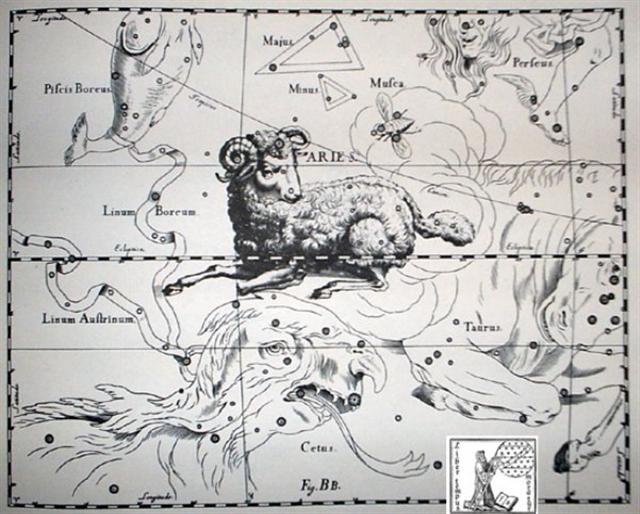 |
The distance from the right ascension position of the Knot (Alrisha) to its culmination (at 21h) was 5 days longer than that of Castor - for the cycle of the Earth around the Sun was not a circle:
| AL-RISHA |
| April 19 (109) |
231 |
Dec 7 (341) |
| right ascension position |
culmination |
Al
Risha
was a
name
quite
similar
to the 7
Rishi
stars in
Ursa
Major (Itzam-Yeh).
...
Proclus
informs
us that
the fox
star
nibbles
continuously
at the
thong of
the yoke
which
holds
together
heaven
and
earth;
German
folklore
adds
that
when the
fox
succeeds,
the
world
will
come to
its end.
This fox
star is
no other
than
Alcor,
the
small
star g
near
zeta
Ursae
Majoris
(in
India
Arundati,
the
common
wife of
the
Seven
Rishis,
alpha-eta
Ursae
...
... The
story of
Rip Van
Winkle
is set
in the
years
before
and
after
the
American
Revolutionary
War. Rip
Van
Winkle,
a
villager
of Dutch
descent,
lives in
a nice
village
at the
foot of
New
York's
Catskill
Mountains.
An
amiable
man
whose
home and
farm
suffer
from his
lazy
neglect,
he is
loved by
all but
his
wife.
One
autumn
day he
escapes
his
nagging
wife by
wandering
up the
mountains.
After
encountering
strangely
dressed
men,
rumored
to be
the
ghosts
of Henry
Hudson's
crew,
who are
playing
nine-pins,
and
after
drinking
some of
their
liquor,
he
settles
down
under a
shady
tree and
falls
asleep.
He wakes
up
twenty
years
later
and
returns
to his
village.
He finds
out that
his wife
is dead
and his
close
friends
have
died in
a war or
gone
somewhere
else. He
immediately
gets
into
trouble
when he
hails
himself
a loyal
subject
of King
George
III, not
knowing
that in
the
meantime
the
American
Revolution
has
taken
place.
An old
local
recognizes
him,
however,
and
Rip's
now
grown
daughter
eventually
puts him
up
...
... The
story is
a close
adaptation
of
Peter
Klaus
the
Goatherd
by
J.C.C.
Nachtigal,
which is
a
shorter
story
set in a
German
village.
The
story is
also
similar
to the
ancient
Jewish
story
about
Honi
M'agel
who
falls
asleep
after
asking a
man why
he is
planting
a
carob
tree
which
traditionally
takes 70
years to
mature,
making
it
virtually
impossible
to ever
benefit
from the
tree's
fruit.
After
this
exchange,
he falls
asleep
on the
ground
and is
miraculously
covered
by a
rock and
remains
out of
sight
for 70
years.
When he
awakens,
he finds
a fully
mature
tree and
that he
has a
grandson.
When
nobody
believes
that he
is
Honi,
he prays
to God
and God
takes
him from
this
world.
Note
also
that the
family
name of
Honi
is also
a term
of
geometry
('M'agel'
is
Hebrew
for
'circle
maker'),
as well
as the
family
name of
Rip ('Winkel'
is
German
for
'angle').
The
story is
also
similar
to a 3rd
century
AD
Chinese
tale of
Ranka,
as
retold
in
Lionel
Giles in
A
Gallery
of
Chinese
Immortals.
In
Orkney
there is
a
similar
and
ancient
folklore
tale
linked
to the
Burial
mound of
Salt
Knowe
adjacent
to the
Ring of
Brodgar.
A
drunken
fiddler
on his
way home
hears
music
from the
mound.
He finds
a way in
and
finds
the
trowes
(Trolls)
having a
party.
He stays
and
plays
for two
hours,
then
makes
his way
home to
Stenness,
where he
discovers
fifty
years
have
passed.
The
Orkney
Rangers
believe
this may
be one
source
for
Washington
Irving's
tale,
because
his
father
was an
Orcadian
from the
island
of
Shapinsay,
and
would
almost
certainly
have
often
told his
son the
tale.
The
original
story
was by
Diogenes
Laertius,
an
Epicurean
philosopher
circa
early
half
third
century,
in his
book
On the
Lives,
Opinions,
and
Sayings
of
Famous
Philosophers.
The
story is
in
Chapter
ten in
his
section
on the
Seven
Sages,
who were
the
precursors
to the
first
philosophers.
The sage
was
Epimenides.
Apparently
Epimenides
went to
sleep in
a cave
for
fifty-seven
years.
But
unfortunately,
'he
became
old in
as many
days as
he had
slept
years'.
Although
according
to the
different
sources
that
Diogenes
relates,
Epimenides
lived to
be one
hundred
and
fifty-seven
years,
two
hundred
and
ninety-nine
years,
or one
hundred
and
fifty-four
years.
A
similar
story is
told of
the
Seven
Sleepers
of
Ephesus,
Christian
saints
who fall
asleep
in a
cave
while
avoiding
Roman
persecution,
and
awake
more
than a
century
later to
find
that
Christianity
has
become
the
religion
of the
Empire
...

|





